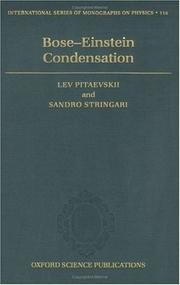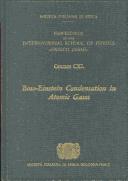| Listing 1 - 6 of 6 |
Sort by
|

ISBN: 0198507194 Year: 2003 Publisher: Oxford Clarendon Press
Abstract | Keywords | Export | Availability | Bookmark
 Loading...
Loading...Choose an application
- Reference Manager
- EndNote
- RefWorks (Direct export to RefWorks)
This book is an introductory text to the physics of Bose-Einstein condensation. This phenomenon, first predicted by Einstein in 1925 has been realized experimentally in 1995 in a remarkable series of experiments whose importance has been recognized by the award of the 2001 Nobel Prize in Physics. The condensate is actually a new state of matter, where quantum-mechanical wave functions of atoms behave as coherent matter waves in the same way as coherent light waves in the case of a laser. The authors provide a theoretical presentation of the main concepts underlying the physics of dilute atomic gases in conditions of extremely low temperatures where quantum effects play a crucial role. The main effort is devoted to discussion of the relevant theoretical aspects exhibited by these systms, such as the concept of order parameter, long range order, superfluidity and coherence. The mathematical formalism is presented in a form convenient for practical use. The book develops the theory of Bose gases starting from the pioneering Bogoliubov approach and gives special emphasis to the new physical features exhibited by non-uniform gases which are produced in the recent experiments with magnetic and optical traps. These features include the determination of the equilibrium profiles, the collective oscillations, the mechanism of the expansion of the gas after releasing the trap, the interference patterns obtained by overlapping two condensates, the rotational properties revealing the effects of superfluidity the Josephson-like phenomena assocaited with the coherence of the phase, the beyond mean field phenomena exhibited by quantum gases in conditions of reduced dimensionality. The book also discusses the alaogies and differences with the physics of "classical" superfluids like liquid helium and introduces some of the major features of trapped Fermi gases at low temperature, pointing out the consequences of superfluidity.
Matter physics --- 533.1 --- Bose-Einstein condensation --- Bose condensed fluids --- Bose condensed liquids --- Bose fluids --- Bose liquids --- Einstein condensation --- Bosons --- Condensation --- Superfluidity --- Properties of gases --- Bose-Einstein condensation. --- 533.1 Properties of gases --- Bose-einstein condensation

ISBN: 1614992258 9781614992257 0967335558 9780967335551 4274903125 9784274903120 Year: 1999 Publisher: Amsterdam IOS Press
Abstract | Keywords | Export | Availability | Bookmark
 Loading...
Loading...Choose an application
- Reference Manager
- EndNote
- RefWorks (Direct export to RefWorks)
Although first proposed by Einstein in 1924, Bose-Einstein condensation (BEC) in a gas was not achieved until 1995 when, using a combination of laser cooling and trapping, and magnetic trapping and evaporation, it was first observed in rubidium and then in lithium and sodium, cooled down to extremely low temperatures. This book brought together many leaders in both theory and experiment on Bose-Einstein condensation in gases. Their lectures provided a detailed coverage of the experimental techniques for the creation and study of BEC, as well as the theoretical foundation for understanding the
Bose-Einstein condensation --- Condensation --- Change of state (Physics) --- Chemistry --- Bose condensed fluids --- Bose condensed liquids --- Bose fluids --- Bose liquids --- Einstein condensation --- Bosons --- Superfluidity --- Matter physics
Book
ISBN: 0521464730 Year: 1995 Publisher: Cambridge : Cambridge University Press,
Abstract | Keywords | Export | Availability | Bookmark
 Loading...
Loading...Choose an application
- Reference Manager
- EndNote
- RefWorks (Direct export to RefWorks)
Bose-Einstein condensation --- Bose-Einstein, Condensation de
Book
ISBN: 0511524242 Year: 1995 Publisher: Cambridge : Cambridge University Press,
Abstract | Keywords | Export | Availability | Bookmark
 Loading...
Loading...Choose an application
- Reference Manager
- EndNote
- RefWorks (Direct export to RefWorks)
This is the first book devoted to Bose-Einstein condensation (BEC) as an interdisciplinary subject, covering atomic and molecular physics, laser physics, low temperature physics and astrophysics. It contains 18 authoritative review articles on experimental and theoretical research in BEC and associated phenomena. Bose-Einstein condensation is a phase transition in which a macroscopic number of particles all go into the same quantum state. It has been known for some time that this phenomenon gives rise to superfluidity in liquid helium but recent research has focused on the search for BEC in other condensed matter systems, such as excitons, spin-polarised hydrogen, laser-cooled atoms, high-temperature superconductors and subatomic matter. This unique book gives an in-depth report on progress in this field and suggests promising research topics for the future. It will be of interest to graduate students and research workers in condensed matter, low temperature, atomic and laser physics.
Book
ISBN: 9780511524240 9780521464734 9780521589901 Year: 1995 Publisher: Cambridge Cambridge University Press
Abstract | Keywords | Export | Availability | Bookmark
 Loading...
Loading...Choose an application
- Reference Manager
- EndNote
- RefWorks (Direct export to RefWorks)
Book

ISBN: 1614996946 9781614996941 9781614996934 9788874381050 8874381050 Year: 2016 Publisher: Amsterdam, Netherlands : IOS Press,
Abstract | Keywords | Export | Availability | Bookmark
 Loading...
Loading...Choose an application
- Reference Manager
- EndNote
- RefWorks (Direct export to RefWorks)
| Listing 1 - 6 of 6 |
Sort by
|

 Search
Search Feedback
Feedback About UniCat
About UniCat  Help
Help News
News